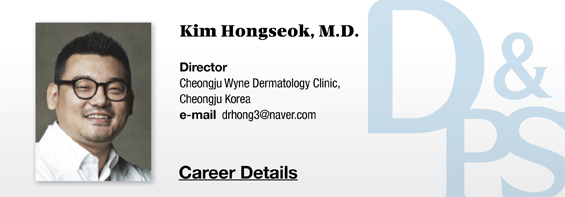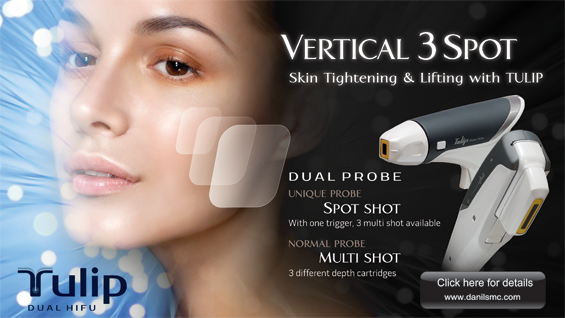
Lactic Acid
Lactic acid is a common AHA found in many DUI facial products and prescribed cosmetics. Lactic acid is one of NMFs and is an excellent moisturizer. Currently, 12% buffered ammonium lactate lotion (LacHydrin) was withdrawn from the market in Korea but I used to prescribe this agent frequently. Many dermatologists are aware of its excellent moisturizing effect. Similar to glycolic acid, lactic acid also has anti-aging effect. Studies have reported that it helps strengthen the skin and thicken the thickness and evens the skin texture. Topical application of 5% and 12% lactic acid was found to improve the texture and water content of the skin. Such effect is limited to the epidermis and there was no change in the dermal thickness or density. AHA is widely used in daily lives and included in many cleansers and moisturizing products but daily exposure actually induces tolerance and lowers its effect. The cause has not been clarified, however, continuous contact with AHA is conjectured to induce a natural acid buffer action of the skin to neutralize acid. Therefore, for the success of long-term use of hydroxyl acid, it is advisable to discontinue the use sporadically. If continuous AHA fails to bring effect, discontinue treatment and observe the outcome before resuming AHA treatment.
[Advertisement] Tulip(Skin Tightening & Lifting) – Manufacturer: DANIL SMC(www.danilsmc.com)
Whereas AHA improves the density of the stratum corneum, SA does not. In the past, AHA was thought to make the skin thinner, however, it has not been confirmed. An animal study examining the negative impact of AHA on the skin barrier found that skin permeation did not significantly differ in the groups using 5% and 10% GA of pH 3.0 with that of the controls. Rather, the treatment group had thicker skin with doubled number of nuclear cell layer[i]. AHA has the risk of photosensitivity. The skin turned darker from UVB irradiation after topical application of 10% GA. In Asians, it was found that UVA-induced tanning was also more effective after 10% GA exposure[ii]. Many cosmetics manufacturers found that the number of sunburned cells increased in AHA group. The FDA is currently working to include a warning about photosensitivity in the label of AHA containing products. I think dermatologists should inform patients about the risk of photodamage and importance of using a sunscreen after the AHA treatment.
BHA
The most common type of BHA used in aesthetic treatment is salicylic acid (SA). Similar to AHA, 20~30% SA results in improved lesions, smoother texture and reduced fine wrinkles in most clinical cases[iii]. A study conducted in the early 1990s found that applying 50% SA on the hand and forearm led to change in coloration[iv]. As with AHA, SA also seems to accelerate cellular cycles and promote natural exfoliation. However, unlike AHA, BHA has anti-inflammatory action through arachidonic acid cascade which makes it less irritating than AHA. The incidence of side effects was 20% in those treated with GA and 4-7% in those treated with SA[v]. SA is mild and is a safe homecare peeling agent in acne and rosacea. In accordance with cosmetics safety regulations of Korea, the SA concentration cannot exceed 0.5% and SA cannot be used in children aged 3 or younger.
SA peel is effective for relieving red inflamed acne and comedone. It also effectively clarifies darker skin ton[vi]. Topical application of 30% SA once every two weeks in 24 Asian women for 3 months resulted in clearer skin tone. Caution should be taken with darker skin as it has a higher risk of PIH. AHA promoted collagenesis but BHA did not. Collagenesis following use of AHA and retinol seems to arise from inflammatory response. If this is true, SA would also promote collagenesis.
BHA is different from AHA in that it is lipophilic and penetrates the follicular sebum to improve pores. AHA is water-soluble and does not dissolve comedone.
|
|
AHAs |
BHAs |
|
Photo-aging |
Yes |
Yes |
|
Acne |
Yes |
Yes |
|
Melasma |
Yes |
Yes |
|
Dryness |
Yes |
Yes |
|
Accelerate cell cycle |
Yes |
Yes |
|
Lipophilic |
No |
Yes |
|
Inhibit arachidonic acd |
Yes |
Yes |
|
Anti-inflammation |
Maybe |
Yes |
|
Post-treatment neutralization |
Yes |
No |
|
Post-application frost |
No |
Yes |
|
Increased collagenesis |
Yes |
No |
|
Safe during pregnancy/breast feeding |
Yes |
No |
Table 1. Characteristics of AHA and BHA.
[i] Hood H, Kraeling M, Robl M, et al. The effects of an alpha hydroxy acid (glycolic acid) on hairless guinea pig skin permaeability. Food Chem Toxicol 1999;37:1105
[ii] Tsai T, Paul B, Jee S, et al. Effects of glycolic acid on light-induced skin pigmentation in Asian and Cacasian subjects. J Am Acad Dermatol. 2000;43:238
[iii] Kligman D, Kligman AM. Salicylic acid peels for the treatment of photoaging. Dermatol Surg. 1998;24:325
[iv] Swinehart JM. Salicylic acid ointment peeling of the hands and forearms. Effective nonsurgical removal of pigmented lesions and actinic damage. J Dermatol Surg Oncol. 1992;18:495
[v] Kligman A. A comparative evaluation of a novel low-strength salicylic acid crean and glycolic acd. Products on human skin. Cosmet Dermatol. 1997;10 (suppl):11S
[vi] Ahn HH, Kim IH. Whitening effect of salicylic acid peels in Asian patients. Dermatol Surg. 2006;32:372




















